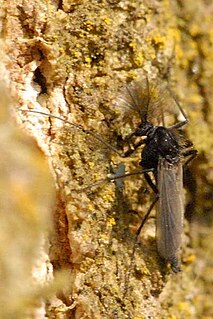
The Chironomidae comprise a family of nematoceran flies with a global distribution. They are closely related to the Ceratopogonidae, Simuliidae, and Thaumaleidae. Many species superficially resemble mosquitoes, but they lack the wing scales and elongated mouthparts of the Culicidae.
Conchapelopia is a genus of flies belonging to the family Chironomidae.

Orthocladiinae is a subfamily of midges in the non-biting midge family (Chironomidae). For lack of a better common name, they are simply referred to as orthoclads.

Tanytarsus is a large genus of non-biting midges of the tribe Tanytarsini and subfamily Chironominae of the bloodworm family (Chironomidae). The larvae of these insects occur in a wide range of freshwater habitats with some species being marine.

Chironominae is a subfamily of midges in the non-biting midge family (Chironomidae).

Chironomini is a tribe of midges in the non-biting midge family (Chironomidae).
Cladopelma is a genus of non-biting midges in the subfamily Chironominae and tribe Chironomini of the bloodworm family Chironomidae. Species are distributed world-wide, with species represented in the Palaearctic, Nearctic, Neotropical, Afrotropical, Sino-Indian, and Austroasian regions.
Cladotanytarsus is a genus of European non-biting midges in the subfamily Chironominae of the bloodworm family Chironomidae.
Paratanytarsus is a genus of European non-biting midges in the subfamily Chironominae of the bloodworm family Chironomidae.
Parachironomus is a genus of non-biting midges in the subfamily Chironominae of the bloodworm family Chironomidae.
Beardius is a genus of Pan-American non-biting midges in the subfamily Chironominae of the bloodworm family Chironomidae. It is named after the late Melvin Beard, a student at Eastern New Mexico University.

Tanytarsini is a tribe of midges in the non-biting midge family (Chironomidae).

Tanypodinae is a subfamily of midges in the non-biting midge family (Chironomidae). The larvae are generally carnivorous and their mouthparts are adapted for predation on small invertebrates although 1st and 2nd instar larvae also feed on algae.

Procladius is a genus of non-biting midges in the subfamily Tanypodinae of the bloodworm family Chironomidae.
Pentaneurini is a tribe of midges in the non-biting midge family (Chironomidae).
Thalassomya is a genus of midges in the non-biting midge family (Chironomidae).
Diamesinae is a subfamily of midges in the non-biting midge family (Chironomidae).
Diamesini is a tribe of midges in the non-biting midge family (Chironomidae).
Diamesa is a genus of non-biting midges in the subfamily Diamesinae of the bloodworm family Chironomidae.

Goeldichironomus is a genus of midges in the family Chironomidae. There are about 14 described species in Goeldichironomus.






